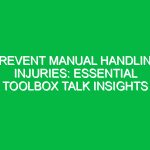Understanding PPE in the HSE Context
Personal Protective Equipment (PPE) encompasses a range of protective clothing, helmets, goggles, and other gear designed to safeguard the wearer from injury or infection. In the Health, Safety, and Environment (HSE) domain, the significance of PPE cannot be overstated. The right PPE can mean the difference between a safe working environment and a hazardous one, especially in industries where exposure to harmful substances and environments is routine.
PPE pics, or images depicting various types of Personal Protective Equipment, play a crucial role in educating individuals about the necessary gear for specific tasks. They serve as visual aids in Training sessions, safety briefings, and compliance documentation. By providing clear and informative visuals, PPE pics enhance understanding and retention, ensuring that employees are better prepared to protect themselves in potentially dangerous situations.
The Importance of PPE Pics in HSE Training
Effective training in health and Safety practices is vital for any organization. One of the most effective tools in this regard is the use of PPE pics. These images can illustrate proper usage, demonstrate how to wear equipment correctly, and highlight the importance of compliance with Safety Regulations.
- Visual Learning: Many individuals retain information better through visual aids. PPE pics can bridge the gap between theoretical knowledge and practical application.
- Accurate Representation: High-quality images can accurately showcase the equipment, ensuring employees know what to look for when selecting PPE.
- Real-World Scenarios: Demonstrating PPE usage in realistic situations can help employees understand the context in which they will need to use their protective gear.
Key Components of PPE in the HSE Domain
To understand PPE fully, it is essential to break down its key components as they relate to the HSE context. Each type of PPE serves a specific purpose and addresses particular risks. Here are some critical categories:
Head Protection
Hard hats are one of the most recognizable PPE items, designed to prevent head injuries from falling objects. PPE pics showcasing hard hats can provide insight into the different types available, including those with additional features like face shields or reflective strips for enhanced safety in low-light conditions.
Eye and Face Protection
Safety Goggles and face shields protect against chemical splashes, flying debris, and harmful radiation. High-quality PPE pics can show the various styles and lenses appropriate for different situations, helping users select the correct protection based on their work environment.
Respiratory Protection
Respirators and masks are critical in environments where harmful dust, fumes, or vapors are present. Images of various types of masks, including N95 respirators and full-face masks, can educate workers on proper fit and usage, emphasizing the importance of sealing and Maintenance.
Hand Protection
From cut-resistant gloves to chemical-resistant ones, the appropriate hand protection varies greatly depending on the task. PPE pics can highlight the material properties and design features of different gloves, aiding in the selection process based on specific Hazards.
Foot Protection
Safety shoes and boots with steel toes or slip-resistant soles help prevent injuries from heavy objects or slippery surfaces. Images illustrating the variety of styles available can guide employees in choosing suitable footwear for their roles.
Body Protection
Coveralls, vests, and aprons are Types of PPE designed to protect the body from chemicals, heat, and other Hazards. Images can demonstrate the differences in materials, such as flame-retardant or chemical-resistant options, and their respective applications.
Potential Hazards and Risks in the HSE Context
Understanding the risks associated with various work environments is crucial for selecting the appropriate PPE. Here are some common hazards that necessitate the use of PPE:
- Chemical Exposure: Industries such as pharmaceuticals and manufacturing often deal with hazardous chemicals that can cause severe health issues. PPE pics can illustrate the necessary protective gear, such as gloves and goggles.
- Physical Injuries: Construction sites pose risks from falling objects, heavy machinery, and sharp tools. Images showcasing hard hats, steel-toed boots, and high-visibility vests can reinforce safety protocols.
- Biological Hazards: In healthcare settings, exposure to diseases requires specific PPE, including gowns, masks, and gloves. PPE pics can serve as reminders of the proper equipment needed to minimize risk.
- Environmental Conditions: Extreme temperatures, whether hot or cold, can pose risks. PPE images that demonstrate insulated clothing or cooling vests can help workers prepare adequately.
Regulations and Standards Governing PPE
The use of PPE is not only a best practice but often a legal requirement. Various regulations govern the selection, use, and maintenance of PPE, ensuring that workers are adequately protected. Some key regulations include:
Occupational Safety and Health Administration (OSHA)
osha sets forth standards that require employers to provide appropriate PPE for employees exposed to hazards. Understanding these regulations is crucial for both employers and employees. PPE pics can help illustrate compliance and ensure that all personnel are aware of their rights and responsibilities.
Personal Protective Equipment at Work Regulations 1992 (UK)
For those in the UK, these regulations outline the employer’s duty to assess risks and provide suitable PPE to employees. Images demonstrating compliance can serve as valuable reminders of the importance of safety in the workplace.
American National Standards Institute (ANSI)
ANSI provides voluntary consensus standards for various types of PPE. Understanding these standards can help organizations select appropriate equipment that meets safety requirements. PPE pics can assist in showcasing ANSI-approved gear.
Best Practices for Using PPE
To maximize the effectiveness of PPE, it is essential to follow Best Practices. Here are several guidelines that can enhance safety in the workplace:
- Regular Training: Conduct ongoing training sessions that include the latest PPE pics to ensure that all employees understand the equipment and its proper use.
- Routine Inspections: Regularly inspect PPE for signs of wear and tear. Images demonstrating common wear indicators can help employees recognize when equipment needs to be replaced.
- Proper Storage: Store PPE in a clean, dry location to prevent damage. Visuals of appropriate storage practices can help maintain the integrity of the equipment.
- Encourage Reporting: Foster an environment where employees feel comfortable reporting issues with their PPE. This openness can lead to improvements in safety practices.
Real-Life Examples of Effective PPE Usage
The impact of proper PPE usage can be illustrated through various case studies. For instance, a construction company that implemented a comprehensive PPE program saw a significant reduction in workplace injuries. By providing high-quality PPE and regular training sessions—including the use of PPE pics—the company cultivated a culture of safety that empowered workers.
Another example can be found in healthcare settings where proper PPE usage has been vital during outbreaks, such as the COVID-19 pandemic. Hospitals that effectively utilized PPE pics in training and compliance reporting were better equipped to protect their staff and patients from infections.
Conclusion: The Ongoing Importance of PPE in HSE
In conclusion, PPE is an essential element of health, safety, and environmental practices across various industries. By utilizing PPE pics, organizations can enhance training, improve understanding, and promote compliance with safety regulations. These images are more than just visuals; they represent a commitment to protecting the workforce and fostering a culture of safety.
As workplaces evolve and new hazards emerge, the role of PPE will only grow in importance. Organizations must continue to prioritize effective training and make the best use of available resources, including PPE pics, to ensure that every worker is equipped to face the challenges ahead.


